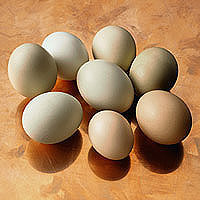Gluten Free
What does following a gluten-free diet mean? That you're embarking on an easy diet with a wide range of health-promoting effects. Instead of dwelling on what you’re giving up, consider that you’re going to enjoy a whole new world of delicious food options to meet your special dietary needs. You’ll be eating seasonally, choosing more fresh fruits and vegetables, focusing on meats, seafood, poultry, legumes, lentils, corn, and rice, and discovering fascinating ancient grains such as quinoa, amaranth, and millet. You’ll be able to eat potatoes, eggs, most cheeses, even chocolate (!)—and enjoy them without guilt because you’ll be taking good care of your body. In fact, you’ll probably end up eating—and feeling—better than ever!
Visit this page for more information about living Gluten Free
---
We carry a large variety of gluten free items, the brands listed below represent just some of the offerings we carry















More Diets
Eggs

Preparation, Uses, & Tips
Eggs are the centerpiece of a range of foods. Many egg dishes, such as omelets and frittatas, can be prepared quickly with many interesting fillings, such as peppers, tomatoes, or zucchini.
Basic egg dishes
Even the humble scrambled egg becomes a meal in itself when it’s served with spicy potatoes. Other types of egg dishes that require more planning and preparation time include baked (shirred) eggs, which become eggs Florentine when prepared with spinach (or zucchini). Baked soufflés are a classic egg dish—or bake miniature soufflés (served in ramekins, or individual serving dishes); season these with ingredients that can be varied endlessly. Or try timbales, for which the eggs are beaten rather than whipped like soufflés, and may then be mixed with a puréed vegetable, such as asparagus, before baking.
Omelettes
One of the most popular egg dishes is the omelette. Making an omelette is a process that mixes technique and personal artistry. Use a 9- or 10-inch (23- to 25-cm) sauté pan with rounded, sloping sides. Be sure the surface of the pan is smooth and slick so that the egg mixture does not stick to the pan. For a two- or three-egg omelette, break the eggs into a bowl, add about 1 tablespoon (15mL) of cold water, and salt to taste. Beat the eggs thoroughly with a fork. When the pan is hot enough to make a drop of water sizzle, add 1 tablespoon of butter to coat the surface. Pour the egg mixture into the pan, and give it one quick swirl with the fork. As it begins to set, gently lift the edges with a fork or spatula so the liquid on top can run underneath. The omelette should be thoroughly cooked on both sides (based on safety guidelines), so once it is done, turn it as you would a pancake and cook the other side briefly to ensure that all surfaces of the egg are cooked to the point where they are no longer moist.
Hard-cooked eggs
When preparing hard-cooked eggs, choose large eggs, place them in a pan, and cover with cold water. Simmer eggs at 185 to 190°F (85 to 87.7°C) for 7 minutes. Cool immediately in cold water. Peel when cool.
Frying eggs
Frying eggs by steam-basting cuts the amount of fat needed. Coat the pan lightly with oil or butter, heat it over a medium heat, and crack the egg into the pan. Reduce the heat to low and cook for 1 minute, then add 1 teaspoon (5mL) of water, cover the pan tightly, and cook for at least 6 more minutes.
Poached eggs
Cook poached eggs until the yolks are firm. Bring 1 to 2 inches (2.54 to 5 cm) of water to a simmer in a saucepan or small skillet, break an egg into a cup and, holding the cup just above the surface of the water, gently slide the egg into the pan. (You may wish to stir a little “whirlpool” into the simmering water before adding the egg, to help the egg keep its shape.) Cook until the white and yolk are both firm, which takes about 5 minutes. Lift the egg out with a slotted spoon and drain it on paper towels.
Scrambled eggs
To prepare scrambled eggs, break the eggs into a bowl, add a tablespoon of cold water, and whisk together so that the yoke and whites are blended. Coat the pan lightly with oil or butter, heat it over a medium heat, and pour the egg mixture into the pan. As the mixture begins to set, use a spatula to scrape the eggs from the edge of the pan to the center. Cook until the mixture is firm; scrambled eggs should not be runny.
Cooking temperature
No matter how you are preparing eggs, always cook them thoroughly, bringing the temperature to 160°F (71°C) or higher for at least 3 minutes.
Copyright © 2025 TraceGains, Inc. All rights reserved.
Learn more about TraceGains, the company.
The information presented in the Food Guide is for informational purposes only and was created by a team of US–registered dietitians and food experts. Consult your doctor, practitioner, and/or pharmacist for any health problem and before using any supplements, making dietary changes, or before making any changes in prescribed medications. Information expires December 2025.











